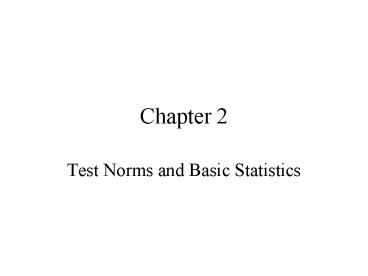Test Norms and Basic Statistics - PowerPoint PPT Presentation
1 / 24
Title:
Test Norms and Basic Statistics
Description:
The numbers under the normal curve are the proportions of cases we would expect ... Easily understood, naturalness to their meaning. ... – PowerPoint PPT presentation
Number of Views:333
Avg rating:3.0/5.0
Title: Test Norms and Basic Statistics
1
Chapter 2
- Test Norms and Basic Statistics
2
Types of Scores
- Raw score immediate result of an individuals
responses to a test - Normed score result of comparing an
individuals raw score to those of individual in
a norm group. Also called derived score or scale
scores. - Test norms are based on the elementary notions
from descriptive statistics, so we will do a
quick review.
3
Why we need statistics
- To describe a set of data (descriptive
statistics) - To make inferences (inferential statistics)
4
Levels of Variables
- Define construct Most general level. Give
verbal descriptions and definitions of a
variable. - Measure variable this is the operational
definition of the variable. - Get raw data This is the result of the
application of the measures
5
Types of Scales
- Nominal (Names)
- Ordinal (Ranks /Order)
- Interval (Equal intervals)
- Ratio (Absolute zero, can form ratios)
6
Organizing Raw Data
- Frequency distributions can be grouped or
ungrouped - X axis individual scores or intervals
- Y axis frequency
7
Percentiles and Percentile Ranks
- Percentile is a point on a scale below which a
specified percentage of the cases fall. Start
with a given percentage, then find the raw score
corresponding to this point. (e.g., what score
corresponds to the 50th percentile?) - Percentile rank tells the percentage of cases in
the norm group falling below a given raw score.
Start with the score, then find the percentage of
cases falling below it. (e.g., what percentage
of the class scored less than 75 on the test?)
8
Calculating a percentile rank or percentile
- Pr (B/N) x 100
- Where
- Prpercentile rank
- Bnumber of scores below score of interest
- Ntotal number of scores
- Xscore of interest
- Remember to arrange data so best is on the top
and worst is on the bottom
9
Strengths and Weaknesses of Percentiles and
Percentile Ranks
- Strengths
- Easy to understand
- Easy to calculate
- Weaknesses
- Confused with percentage right score
- Inequality of units at various points on the
scale. (Percentile ranks are bunched up in the
middle of the distribution.)
10
Measures of Central Tendency
- Mean
- Median 50th percentile, middle score when the
scores are arranged from low to high - Mode Most frequent score
11
Measures of Variability
- Range distance from the lowest to the highest
score - Standard deviation average deviation around the
mean.
12
Definitional formula for calculating the standard
deviationfor a population
13
Computational Formula for Calculating the
Standard Deviation for a Sample
14
Z-Scores
Mean of 0 Standard Deviation of 1 Tells how
far the score is from the mean and in what
direction
15
Standard Normal Deviation
- Uses the normal distribution, i.e., a symmetrical
binomial probability distribution - Refer to the units on the X axis in Z score units
- The numbers under the normal curve are the
proportions of cases we would expect to observe
in each area. - Proportions which begin at the bottom of the
normal curve to the point of interest are
percentiles or percentile ranks when multiplied
by 100
16
(No Transcript)
17
McCalls T scores
- Transformed z scores to have a mean of 50 and SD
of 10. - T10Z 50
- Used by MMPI and Strong Interest Inventory.
18
Transforming z-scores to other standard scores
Once Z-scores have been obtained, they can be
transformed into any other set of scores with
the desired mean and standard deviation
New Score Z(new std. dev.) new mean
19
Other standard scores
- Quartiles (distribution divided into 4 parts)
- Deciles (distribution divided into 10 parts)
- Stanines (distribution divided into 9 parts)
- They are non-linear transformations since they
are derived by reference to percentile divisions
20
Norms
- Norms refer to the performance of defined groups
on particular tests. - Norms are used to give information about
performance relative to what has been observed in
a standardization sample. - Types of norms
- Percentile ranks
- Standard scores
- Developmental (age-related) Norms
21
Developmental Norms
- Use either age equivalents or grade equivalents
- Are only meaningful in the range where the trait
being measured is developing or growing with time
in the relevant population - MA (mental age) are determined by finding the
typical or median score for examinees at
successive age levels. - Grade equivalents are developed by administering
a test to students in different grade levels.
The average or median performance at each grade
are plotted and a curve fitted.
22
Strengths and Weaknesses of Developmental Norms
- Strengths
- Easily understood, naturalness to their meaning.
- Provide basis for measuring growth across
multi-level tests
- Weaknesses
- Applicable only to variables that show
developmental pattern. - Even variables that are developmental dont
continue that way indefinitely - SD not usually the same on different levels
tests. - same score may be obtained different ways,
23
Issues in Norms Development
- Stability (so need large N) Look also at the
size of the norm group for each population it
represents (e.g., there may be a norm tables for
5th grade girl, but at that level theres only 50
in the norm group) - Representativeness
- Separate norms for separate groups
- Tracking tendency to stay at about the same
level relative to ones peers. (e.g., growth
charts). Issue of children falling behind and
the implications of that
24
Norm- vs. Criterion-referenced Tests
- Norm referenced test compares each person with a
norm. - Criterion referenced test describes the specific
things the test-taker can demonstrate.

